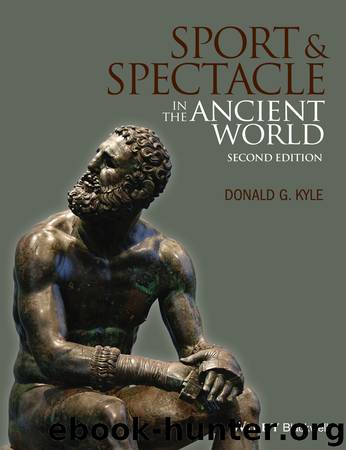Sport and Spectacle in the Ancient World by Kyle Donald G

Author:Kyle, Donald G.
Language: eng
Format: epub
ISBN: 9781118613801
Publisher: Wiley
Published: 2014-12-18T00:00:00+00:00
9
Spartan Sport and Physical Education
Lycurgus exercised the bodies of the virgins with footraces and wrestling and throwing the diskos and akon [javelin] so that their offspring might grow forth from strong roots in strong bodies, and so that they might be patient and strong in childbirth and struggle well and easily with its pains.
Plutarch, Lycurgus 14.2, trans. Miller 2012, no. 153
“Sparta” evokes images of a xenophobic and totalitarian state, the bristling warrior society of Leonidas, the hero of Thermopylae. Sparta so fascinated ancient writers and philosophers that an ancient Spartan mirage developed, which has inspired modern utopian and dystopian visions of either a perfect, ordered, moral society or a mechanical state–dependent on dehumanizing behavioral conditioning. Did Sparta have a sense of true sport—of voluntary, unpredictable free competition—or did Sparta’s arduous system of male (and female) physical education produce tough automatons, rather like the West’s perception of Soviet athletes a few decades ago? Were Spartans physically impressive athletes but by means of a ruthless perversion of sport?
Recent scholarship suggests that Classical Spartan sport and physical education were not so strange after all.1 The Spartans had performative spectacles at home, including contests and rites of passage for young males and females, and they caught the eye of other Greeks with victories and monuments at external games. Modern ideological preferences for Athens or Sparta have obscured the reality that the two most famous Greek states were not so dissimilar in terms of sport and spectacle.
Ancients claimed that Sparta acquired “good order” (eunomia) thanks to Lycurgus, a semilegendary Spartan lawgiver, but Plutarch (Lyc. 1.1) admits that nothing about him is beyond dispute. Instead, modern historians see the “Spartan Revolution” as a process, a series of stages, due to historical exigencies (e.g., wars with neighboring peoples, transitioning to hoplite warfare). We now tend to down date Sparta’s distinctiveness, and the institutionalization of its social system, ethnocentrism, and austerity, to the sixth century. Early Sparta, in fact, was cultured and well connected, innovative in physical education, and regularly successful in external games. Also, rather than remaining a monolithic, static society, as Cicero claims (Pro Flac. 26.63), fifth-century Sparta experienced social change and even a dramatic social (and military) “crisis” (Kennell 1995; Powell and Hodkinson 2002).
Download
This site does not store any files on its server. We only index and link to content provided by other sites. Please contact the content providers to delete copyright contents if any and email us, we'll remove relevant links or contents immediately.
The Inner Game of Tennis by W. Timothy Gallwey(3481)
Unstoppable by Maria Sharapova(3409)
Urban Outlaw by Magnus Walker(3250)
Crazy Is My Superpower by A.J. Mendez Brooks(3210)
Mind Fuck by Manna Francis(3042)
The Social Psychology of Inequality by Unknown(2776)
The Fight by Norman Mailer(2712)
Unstoppable: My Life So Far by Maria Sharapova(2389)
Accepted by Pat Patterson(2221)
Going Long by Editors of Runner's World(2218)
Futebol by Alex Bellos(2138)
The Happy Runner by David Roche(2130)
Motorcycle Man by Kristen Ashley(2120)
Backpacker the Complete Guide to Backpacking by Backpacker Magazine(2116)
The Sports Gene: Inside the Science of Extraordinary Athletic Performance by David Epstein(2064)
Sea Survival Handbook by Keith Colwell(2048)
Peak: Secrets from the New Science of Expertise by Anders Ericsson & Robert Pool(1928)
Endure by Alex Hutchinson(1874)
The Call of Everest by Conrad Anker(1789)
